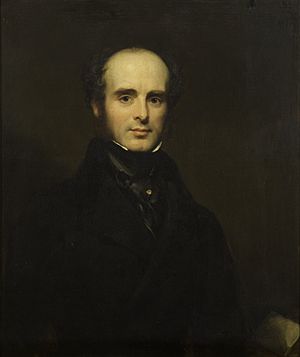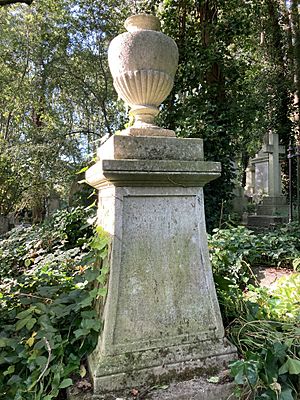James Hope (physician) facts for kids
James Hope (1801–1841) was an important English doctor. Many people call him the first modern heart doctor, also known as a cardiologist. He is famous for finding a specific heart sound in 1829. This sound helps doctors find a problem called mitral stenosis, which affects a valve in the heart.
Contents
James Hope: A Pioneer in Heart Medicine
His Early Life and Studies
James Hope was born in Stockport, Cheshire, on February 23, 1801. His father, Thomas Hope, was a merchant and factory owner. James went to Macclesfield grammar school from 1815 to 1818. After that, he lived in Oxford for about 18 months, but he did not officially join the university there.
In October 1820, James started studying medicine at Edinburgh University. He spent five years there, learning about the human body and diseases. For his final medical paper in 1825, he wrote about aneurysms, which are bulges in blood vessels like the aorta. During this time, he also started collecting drawings of sick body parts he observed. He was even the president of the Royal Medical Society of Edinburgh. He worked as a house-physician and house-surgeon at the Edinburgh Royal Infirmary.
Becoming a Doctor
After leaving Edinburgh in December 1825, Hope continued his medical studies in London at St. Bartholomew's Hospital. In the spring of 1826, he earned his diploma from the Royal College of Surgeons. That summer, he traveled to Europe. He spent a year in Paris, working with a famous doctor named Auguste François Chomel. He then visited Switzerland, Italy, Germany, and the Netherlands. He returned to England in June 1828. In September, he became a licensed doctor with the Royal College of Physicians.
Discovering Heart Sounds
In December 1828, Hope started his own medical practice in London. He also became a student at St. George's Hospital. There, he was one of the first doctors to strongly support using auscultation. This is the method of listening to sounds inside the body, usually with a stethoscope.
Hope was the first to describe a soft heart sound that happens early in the heart's resting phase. This sound is caused by mitral stenosis. He also showed how to tell this sound apart from another heart sound caused by a problem called aortic reflux. For a time, this special heart sound was even called "Hope's murmur."
In 1829, he opened a small clinic that helped people in the Portman Square and Harley Street areas. In 1831, he became a doctor at the Marylebone Infirmary, where he was in charge of 90 patient beds. In 1832, he gave lectures about chest diseases from his home. He later lectured at St. George's Hospital and the Aldersgate Street School of Medicine.
Later Career and Legacy
James Hope studied how the heart makes sounds. He conducted experiments to understand this better. In 1835, his research methods led to some disagreement with another doctor, Charles James Blasius Williams. In 1839, Hope became a full physician at St. George's Hospital. However, his health started to get worse. In July 1840, he became a fellow of the College of Physicians.
He was also chosen as a fellow of the Royal Society in June 1832. He was a member of several medical groups in other countries too. When he stopped working, he was earning a lot of money as a doctor. He was a member of the Church of England and had strong religious beliefs.
Towards the end of 1840, Hope had to stop most of his work. He continued to see a few patients until March 1841, when he moved to Hampstead. He died there on May 12 from a lung disease called pulmonary consumption. He was buried in Highgate Cemetery.
His Important Books
In 1829, Hope started writing many papers that would lead to a big book about the heart. He wrote four papers about aneurysms of the Aorta in the London Medical Gazette in 1829. In 1830, he wrote four more papers for the same journal about heart sounds and how the heart works. He also wrote several articles for the Cyclopædia of Practical Medicine about heart diseases. These articles were published between 1833 and 1835.
Hope's most important book came out in 1831 (dated 1832). It was called A Treatise on the Diseases of the Heart and Great Vessels. This book shared his new ideas about how the heart works and how to understand its sounds. The book was very popular around the world and was even translated into German. A third edition came out in 1839 with pictures, and a fourth edition was published after he died in 1849. Hope's ideas about heart sounds became widely accepted by other doctors.
Hope also wrote a book about sick body parts based on his own drawings. The first part came out in 1833. He also wrote an article about Inflammation of the Brain for another medical book. Days before he died, he finished an article called Notes on the Treatment of Chronic Pleurisy.
Family Life
James Hope married Anne Fulton on March 10, 1831. They had one child together, named Theodore Hope.



